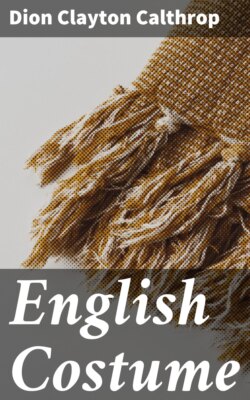Читать книгу English Costume - Dion Clayton Calthrop - Страница 9
На сайте Литреса книга снята с продажи.
ОглавлениеNothing could be plainer or more homely than the dress of a Norman lady. Her loose gown was made with ample skirts reaching well on to the ground, and it was gathered in at the waist by a belt of wool, cloth, silk, or cloth of gold web.
The gown fitted easily across the shoulders, but fell from there in loose folds. The neck opening was cut as the man’s, about five inches down the front, and the border ornamented with some fine needlework, as also were the borders of the wide sleeves, which came just below the elbows.
Often the gown was made short, so that when it was girded up the border of it fell only to the knees, and showed the long chemise below.
The girdle was, perhaps, the richest portion of their attire, and was sometimes of silk diapered with gold thread, but such a girdle would be very costly. More often it would be plain wool, and be tied simply round the waist with short ends, which did not show.
The chemise was a plain white garment, with tight sleeves which wrinkled at the wrists; that is to say, they were really too long for the arm, and so were caught in small folds at the wrist.
The gown, opening at the neck in the same way as did the men’s tunics, showed the white of the chemise, the opening being held together sometimes by a brooch.
Towards the end of the reign the upper part of the gown—that is, from the neck to the waist—was worn close and fitted more closely to the figure, but not over-tightly—much as a tight jersey would fit.
Over all was a cloak of the semicircular shape, very voluminous—about three feet in diameter—which was brooched in the centre or on the shoulder.
A WOMAN OF THE TIME OF WILLIAM I. (1066-1087)
A twist of wool holds the gown at the waist. Under the gown the chemise shows. The neck of the gown is embroidered.
On the head, where the hair was closely coiled with a few curls at the forehead, a wimple was worn, which was wound about the head and thrown over the shoulder, not allowing the hair to show. These wimples were sometimes very broad, and were almost like a mantle, so that they fell over the shoulders below the breast.
Tied round the wimple they sometimes had a snood, or band of silk.
The shoes were like those worn by the men.
These ladies were all housewives, cooking, preparing simples, doing embroidery and weaving. They were their own milliners and dressmakers, and generally made their husbands’ clothes, although some garments might be made by the town tailors; but, as a rule, they weaved, cut, sewed, and fitted for their families, and then, after the garments were finished to satisfaction, they would begin upon strips of embroidery to decorate them.
In such occupation we may picture them, and imagine them sitting by the windows with their ladies, busily sewing, looking up from their work to see hedged fields in lambing-time, while shepherds in rough sheepskin clothes drove the sheep into a neat enclosure, and saw to it that they lay on warm straw against the cold February night.
